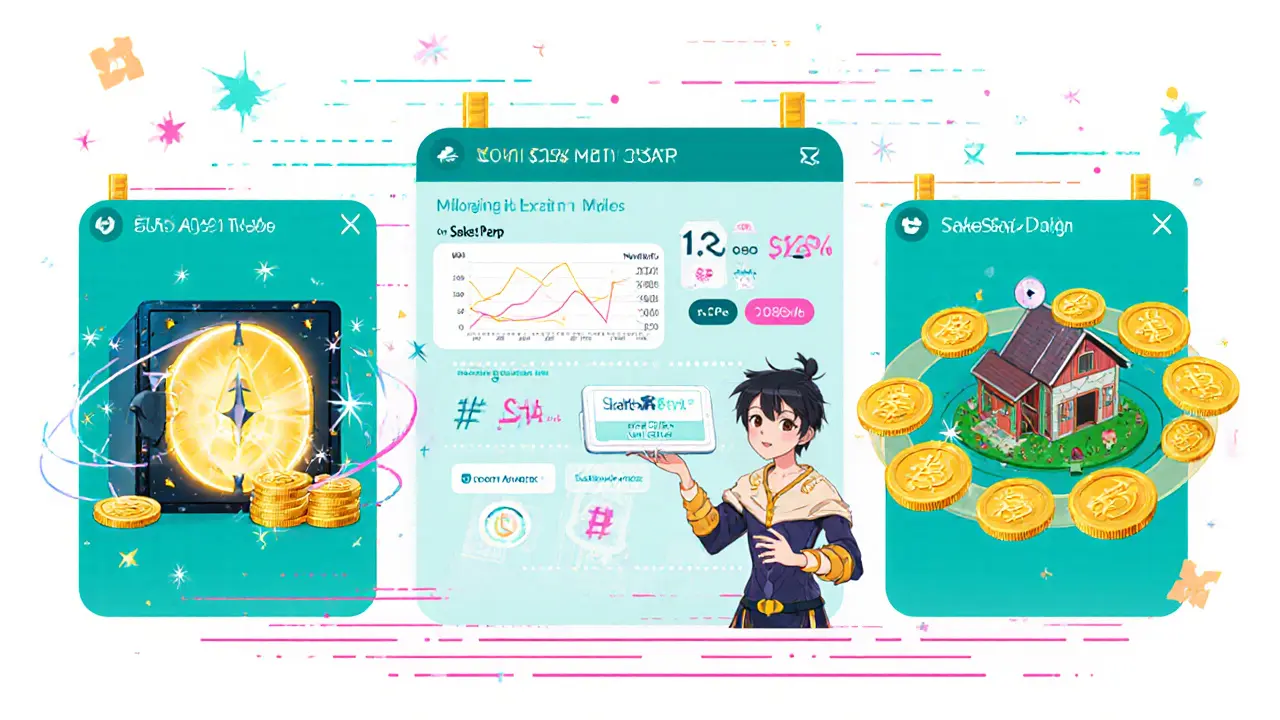Sake Points Calculator
Collateral Supply Points
0 points
Trading Contribution Points
0 points
Borrowing Bonus Points
0 points
SakeSwap LP Points
0 points
Layer3 Quest Points
0 points
Total Estimated Points
0 points
TL;DR
- Connect a Web3 wallet (MetaMask, WalletConnect) to the Sake Finance Rewards page.
- Follow SakeFinance on Twitter and join Discord to claim the "Sipper" role.
- Supply collateral (ETH, WETH, ASTR, USDC.e) on Sake Finance, borrow assets, and keep health factor > 1.
- Complete Layer3 quests and trade on SakePerp to stack Sake Points.
- Track points in the dApp and wait for the retro‑active Sake airdrop when the token allocation is announced.
What is the SAKE ecosystem?
When you hear "SAKE", think of a single governance token that powers three linked DeFi products. First, SakePerp is a perpetual contract trading platform that uses a virtual AMM (vAMM) and an Oracle dual‑price system to keep futures prices in line with the spot market. Second, SakeSwap runs the spot side, offering an AMM DEX and an Initial Liquidity Offering (ILO) engine for new projects. Finally, Sake Finance is a lending‑and‑borrowing protocol built on the Soneium network, where users earn "Sake Points" for every interaction. All three layers share the SAKE token, which serves as governance, fee‑burn, and buy‑back instrument.
How does the SakePerp participants airdrop work?
The airdrop isn’t a one‑off snapshot. Instead, Sake Finance runs a retroactive rewards program called "Sake Points". Every time you trade a perpetual pair on SakePerp-like BTC/BUSD or ETH/BUSD-the protocol logs a point value based on trade volume, fee contribution, and the 50% of fees that feed the SAKE buy‑back pool. Those points accumulate in your wallet and are later converted into SAKE tokens once the team publishes the final allocation schedule.
Key points to remember:
- Only addresses that have signed a transaction on SakePerp earn points.
- Points are weighted by the fee share that goes into the buy‑back pool, not by raw trade volume alone.
- The airdrop caps are undefined, but the protocol promises "no maximum participant limit".
Step‑by‑step guide to qualify for the airdrop
- Connect your wallet. Open the Sake Finance Rewards Program page and click "Connect Wallet". Supported wallets include MetaMask and WalletConnect.
- Verify your social presence. Follow @SakeFinance on Twitter and join the official Discord. Once you have the "Sipper" role, click the verification button on the Rewards page.
- Bridge assets to Soneium. Buy ETH or USDC on Binance, then use the Rhino Bridge to move them to the Soneium network. Make sure you have enough native SONE for gas.
- Supply collateral. Deposit ETH, WETH, ASTR, or USDC.e into the lending pool. Each asset has a collateral factor (e.g., ETH≈80%, USDC.e≈95%). Your health factor must stay above 1.
- Borrow if you want. Take a loan against your collateral-common choices are USDC.e or stablecoins. Borrowing also adds points, provided you keep the health factor safe.
- Trade on SakePerp. Open perpetual positions, pay the 0.05% fee, and watch 90% of that fee burn while 10% goes to SakeBar stakers. The remaining 50% funds the SAKE buy‑back pool, generating more points.
- Complete Layer3 quests. Head to the Layer3 platform, connect your wallet, and finish community tasks like sharing a tweet or answering a quiz. Each completed quest grants extra Sake Points.
- Monitor your points. The Rewards page shows a live tally. Screenshot it periodically for your records.

Maximizing your Sake Points
Simply opening a single position won’t earn you much. To boost your point total, combine activities across the ecosystem:
- Multi‑asset supply. The more collateral types you add, the higher the aggregate point multiplier. For example, holding both ETH and ASTR gives a 1.3× boost compared to a single‑asset supply.
- Active borrowing. Taking out a loan and repaying it within a week adds a "use‑case" bonus. The protocol rewards active credit usage to encourage healthy market depth.
- Frequent trading. Short‑term scalps generate more fees and therefore more points than long‑term holds-just watch the health factor when you add leverage.
- Liquidity provision on SakeSwap. Deposit LP tokens into the SakeSwap Farming pools. Each LP token yields 3% of its withdrawal as a fee, which is earmarked for SAKE buy‑backs, giving you extra points.
- Community engagement. Earn the Discord "Sipper" role, complete the weekly AMA quiz, and retweet official announcements. Each action grants a fixed point bump (usually 5‑10 points).
Because the airdrop is unlimited, the practical limit is your own capital and how much risk you’re comfortable taking.
Reward distribution and tokenomics
When the final allocation is announced, points will be converted to SAKE at a rate set by the governance vote. SAKE tokens received from the airdrop will be subject to the same tokenomics that power the rest of the ecosystem:
- 50% of transaction fees on SakePerp are used for continuous SAKE buy‑backs and locked in an insurance fund.
- 0.05% per‑trade fee: 90% burned, 10% sent to SakeBar stakers (those who lock SAKE for a share of fees).
- Liquidity‑provider fees on SakeSwap are routed to SAKE buy‑backs, reinforcing price support.
In practice, this means that each airdrop token you receive will immediately benefit from ongoing fee redistribution and price‑floor mechanisms.
Risks and things to watch out for
DeFi is inherently risky. Here are the top pitfalls specific to the SAKE airdrop:
- Health factor drops. If market prices swing hard, your collateral could dip below the 1.0 threshold, triggering liquidation and wiping out points you earned through borrowing.
- Network congestion on Soneium. Bridge transactions can become expensive during peak periods, eating into the net gain from points.
- Smart‑contract bugs. While the protocols have been audited, any new feature (e.g., Layer3 quest contracts) could expose new vulnerabilities.
- Regulatory changes. Perpetual contracts may attract scrutiny in some jurisdictions, potentially limiting access.
Mitigate these risks by keeping a diversified portfolio, monitoring gas fees, and staying updated via the official Discord channel.
Quick reference table
| Activity | Base Points | Multiplier | Notes |
|---|---|---|---|
| Supply collateral (single asset) | 10 | 1× | Earned per $1,000 supplied |
| Multi‑asset supply | 10 | 1.3× | Applies when >1 asset supplied |
| Borrow against collateral | 8 | 1.2× | Bonus if loan repaid within 7 days |
| SakePerp trade fee contribution | 15 | Variable (0.5-2×) | Depends on fee share going to buy‑back pool |
| Layer3 community quest | 5-20 | 1× | Fixed per completed task |
| SakeSwap LP farming | 12 | 1.5× | Only while LP tokens are staked |
Next steps after the airdrop
When you finally receive SAKE, consider these actions to keep the cycle profitable:
- Stake your SAKE in the SakeBar to earn a share of the 10% fee pool.
- Provide liquidity on SakeSwap and capture the 3% withdrawal fee that fuels further buy‑backs.
- Continue trading on SakePerp; every new fee contributes to future buy‑back rounds.
- Participate in governance votes-your token weight grows as the ecosystem expands.

Frequently Asked Questions
Do I need to hold SAKE before the airdrop?
No. The airdrop is retroactive; you earn points by using the protocol first, then receive SAKE later.
Can I earn points on other chains?
Points are only counted on the Soneium network where Sake Finance operates. Bridging assets from Ethereum to Soneium is required.
How often are points updated?
The dashboard refreshes every 15 minutes, reflecting the latest trades, supplies, and quest completions.
What happens if my health factor falls below 1?
Your position will be liquidated automatically, and any points earned from that position remain, but you’ll lose the underlying collateral.
When will the SAKE tokens be distributed?
The team has not set a firm date yet. Keep an eye on official announcements; distribution usually follows a governance vote after the points snapshot closes.


Post Comments (18)
The whole Sake Perp airdrop feels like a modern alchemy-promising gold for every trade, yet you’re forced to gamble your collateral on a network you barely know. It’s a seductive dance between risk and reward, but the choreography is hidden behind layers of point multipliers. You end up chasing arbitrary numbers while the protocol quietly reshapes its tokenomics. In the end, the only thing certain is that the system rewards the most aggressive participants, leaving the cautious on the sidelines.
If you’re new to this, start small. Connect your wallet, follow the simple steps, and keep an eye on your health factor. Consistency beats flash‑in‑the‑pan trades, and the points will add up over time.
Meh 🙄.
It is imperative to understand that any DeFi venture carries inherent systemic risk, and the Sake ecosystem is no exception. The protocol’s reliance on a perpetual buy‑back mechanism creates a feedback loop that could amplify market volatility. Participants must therefore maintain a health factor above 1 at all times, or risk liquidation and loss of accrued points. Moreover, the governance model places significant power in the hands of token holders, which may lead to centralization if not carefully monitored.
Your so‑called ‘risk management’ is just wishful thinking; the moment the market dips, the protocol will liquidate you without remorse.
Honestly, this whole points gamification is a gimmick. You could just HODL a decent token and wait for real utility instead of chasing arbitrary scores.
Try bridging during off‑peak hours; gas fees drop dramatically.
Oh wow, another DeFi treasure hunt 🙃. Nothing like spending hours figuring out point multipliers while the coffee brews ☕.
Indeed, the architecture-while intricate-offers a clear pathway; however, one must remain vigilant, for the metrics evolve, and the rewards are contingent upon sustained activity; thus, constant monitoring is essential.
When evaluating the Sake Perp airdrop, the first question you should ask yourself is whether the projected points truly translate into meaningful token value. The protocol’s documentation emphasizes that points are converted at a rate determined by future governance votes, which introduces an element of uncertainty that cannot be ignored. Furthermore, the reliance on the Soneium network adds an extra layer of risk, as bridge congestion and native gas costs can erode any marginal gains from point accumulation. Supply collateral across multiple assets does indeed grant a 1.3× multiplier, but the incremental benefit may be offset by the higher collateral requirements and potential liquidation risk. Active borrowing provides a modest bonus, yet the interest rates and liquidation thresholds mean that only seasoned borrowers should consider this route. Trading frequency dramatically influences the points awarded, with high‑frequency scalping yielding up to a 2× multiplier, but such activity also raises exposure to market volatility and trading fees. Layer3 quests are the low‑effort component, delivering a fixed point bump for community engagement, yet they contribute only a small portion of the overall score. Liquidity provision on SakeSwap adds another avenue for points, but the LP tokens are subject to impermanent loss, and the 1.5× multiplier applies only while the tokens remain staked. In practice, the optimal strategy often involves a blend of these activities, balancing risk and reward rather than chasing a single high‑yield vector. Monitoring the dashboard every fifteen minutes ensures you stay aware of your point trajectory, but it also highlights how dynamic the system truly is. If you neglect the health factor, a sudden price swing can trigger liquidation, instantly nullifying months of point accumulation. Conversely, maintaining a robust health factor above 1.2 provides a safety buffer, allowing you to react to market moves without panic. The governance aspect means that once the airdrop is announced, the community will vote on the conversion rate, potentially favoring larger point holders. This creates a subtle incentive to accumulate points early, as early adopters may secure a better conversion ratio. Nevertheless, the protocol’s tokenomics include continuous buy‑backs and fee burns, which can support the token price over time, benefiting all holders. Ultimately, whether the Sake airdrop is worth your time depends on your risk tolerance, capital availability, and willingness to engage with multiple DeFi layers.
Sure, because more numbers always mean more fun.
Take it step by step; set a realistic daily goal and track your points, you’ll see steady progress.
I’ve been there, keep it simple and don’t stress.
Yea the airdrop sounds cool, just make sure u don’t overdo the tradez 😂
You got this!
Let’s share strategies in the chat, together we can optimize point gains without taking huge risks.
I heard the devs might pull the rug before the vote, keep your eyes peeled.
Don’t ignore the health factor – it’s the only thing stopping you from wiping out.